VI. From Peshawar to Panipat
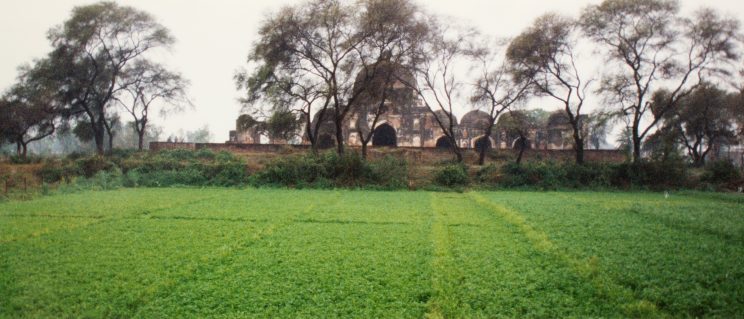

Peshawar
After a long and exciting drive from Kabul, it was early evening when our friends the Elliotts dropped us at Dean’s Hotel in Peshawar, Pakistan. We checked in and immediately set out for a walk. In those days, that is, early 1978, it was fascinating (and safe) to wander around Peshawar’s bazaar. Everything in the world could be found there or found for you—dusty ancient books, rusty old medals, knives and shiny new guns, bales of silks and skins, exotic cosmetics and chemicals, any brass or tin pot ever made, festive garlands and coral, any size hookah, mysterious giant or miniscule carved boxes. Anything!
Up and out early the next morning, we noticed a mysterious rush on TV sets. Any shop with a television put it in the street, usually connected to a long line of extension cords. Maura and I found this as puzzling as the big signs hanging everywhere with a single word—ALI. We wondered if it was a local feast day. Returning to Dean’s lobby we were surrounded by a busload of white-masked, white-slippered Japanese Buddhist tourists, who were as confused as we were. Then we learned that the signs were for boxer Muhammad Ali who was defending his title in Las Vegas that very day. Everyone in the city was searching for a TV to watch the fight. All of Peshawar was in Ali’s corner. He lost, and the stunned city mourned.
Our friend John Cool picked us up at Dean’s, and we headed out on the Grand Trunk Road (GTR), what Kipling called “the river of life,” which extends across the subcontinent. John and my husband, Pat, met in the US Navy and were in graduate school in London at the same time. Since then John had spent his life in Asia. When we moved to New Delhi, we were happy to see him at the airport to greet us. He and his wife, Catherine, a talented Australian painter, had since moved to Islamabad where he was director of the Ford Foundation in Pakistan. Now, beyond the high Himalayas, we could shed our winter gear and stretch in the sunshine.
The GTR took us past Akbar’s majestic 1586 fort at Attock, built by Babur’s grandson Akbar in 1586, which commands the beginning of the Indus River Gorge just beyond the confluence of the Kabul and the Indus Rivers. It is a stirring sight, well described by Mountstuart Elphinstone in the report of his 1808 mission, An Account of the Kingdom of Caubul [Kabul]: “There were numerous rocks at the point of junction, and as both rivers ran with great impetuosity, the sight and the sound produced by the dashing of their waters, were very noble.” He also described the fort: “The Indus was here about 260 yards broad, but too deep and rapid to be correctly sounded. Its banks are of black stone, polished by the force of the stream, and by the white sand which it carries along with it, so as to shine like black marble and always to look as if it were wet.”
Now Maura and I were crossing the path of Alexander the Great, not just following Babur. Arrian recorded that when Alexander reached the plains he split his forces and ordered Hephaestion to the Indus. When Alexander arrived there, he found that Hephaestion had constructed a bridge—the legendary bridge of boats—over the river. This was at Hund, where the river spreads wide, a few miles above Attock and the beginning of the gorge.
South to the Indus
Babur would have known about Alexander, as he had a lifelong interest in poetry and literature. In his youth, he closely followed and even corresponded with Ali-Sher Nawa’i, the leading Timurid intellectual of his day. As an educated person, Babur very likely knew about Alexander’s experience in India and his military engagement with Porus. One of the surprising things I’ve learned in the more than forty years I’ve spent time in India is that Indians—from shopkeepers and taxi wallahs to clerks and professors—all know about Alexander. Known across the Islamic world and in India as Iskandar, the young Macedonian spent six years in this part of the world, from 320 to 326 BCE, but those years had a mysteriously lasting impact. It is also true that Indians take special pride in their ancient culture.
Genghis Khan stopped at the Indus, but Babur’s other empire-building ancestor, Timur, spent days having a bridge of boats built, then made it all the way to Delhi, where he slaughtered the residents and sacked the city. Unlike the previous Islamic invaders from the north, religion was not Babur’s motive; material needs were his driving force. Kabul had become the sanctuary for the widows and children of dozens of Timurid-Chingizid nobles killed by the Uzbeks. His beloved Kabul produced barely enough income from traders in the city, and there were not enough supplies from the countryside to provide for his followers. There simply was no way he could house, feed, and equip the hundreds of dependents flowing into Kabul by 1519. He had to claim the rich north Indian plain.
Babur’s forays south to the Indus followed a five-year (1514–19) gap in the Baburnama. (Translator Wheeler M. Thackston writes that the missing pages were likely lost during a storm.) When the narrative resumes, he is setting out on what appears to be a routine raid for supplies at Bajaur, Pakistan, but suddenly it turns violent: “Since the people of Bajaur were rebels … they were put to massacre and their women and children were taken captive. As there had been no battle on the eastern side, a few men managed to escape from that direction but more than three thousand were put to death.” (Baburnama, f. 218)
This grisly event took place on January 7, 1519, and shortly afterward, on January 21, Babur marched to Swat Valley. There, in a startling change, he formed an alliance with the leader of the Yusufzai by marrying his daughter, Bibi Mubarika. The slaughter at Bajaur served as an example to other chieftains and other areas were easily subdued. Historians regard this episode as an important point in Babur’s career, when he was forming a strategy to take the Punjab and India.
He continued to lead marauding forays, crisscrossing the foothills until February 20 when he spied a beautiful lake some six miles around:
To the north is a beautiful meadow. To the west, at the base of the mountains, is a spring, the water of which stays in the hills overlooking the lake. Since it was a worthy spot, I had a garden called Bagh-i-Safa laid out. It was a pleasant place with good air.… (Baburnama, f. 224)
According to our friend, archaeologist Dr. Saifur Rahman Dar, today all that remains of Babur’s garden is one huge, flat, stone block high above the lake.
Babur’s deep pleasure in nature and the satisfaction he took from taming springs and streams are among his most appealing characteristics. But it can be jarring to read these accounts in the midst of descriptions of brutal military engagements or immediately after he has given orders to build a tower of his enemies’ heads. E. M. Forster was a great admirer of Babur, whom he described with amused affection as a “robber boy, sorely in need of advice, scuttling over the highlands of Central Asia.” He explained the rationale behind the contrasts one encounters in the Baburnama: “It is the temptation of a cultivated man to arrange his experiences, so that they lose their outlines; he, skilled in two languages and all the arts of his day, shunned that false logic, and the sentences in his Memoirs jostle against one another like live people in a crowd.”
For Foster, Babur brought to mind Machiavelli, and he compared the two contemporaries:
Had Machiavelli ever heard of Babur? Probably not, but if the news had come through, how he would have delighted in a career that was not only successful but artistic! And if Babur had ever heard of Machiavelli how gladly he would have summoned him and shown him a thing or two! Yes—a thing or two not dreamt of in that philosophy, things of the earth mostly, but Machiavelli didn’t know about them all the same.
—E. M. Forster, Abinger Harvest (New York: Harcourt Brace Jovanovich, 1971), p. 301.
The Way to Wah
We drove across the Indus on the GTR, crammed between heavily overladen, intensely over-decorated trucks; it felt almost as perilous as Hephaestion’s crossing. Pakistan is crowded with historic sites and ruins, and at no place are the layers of civilization more evident than at Taxila, an ancient Gandharan city. According to ancient Persian inscriptions, Gandhara was a satrapy of the Achaemenid Empire; Cyrus crossed the Hindu Kush mountains to collect tribute there. Maura had a growing interest in Buddhism and shared the story of Taxila, which had been built on the site of an Indus Valley settlement that flourished four thousand years ago. Taxila is associated with Kunala, the son of the great Buddhist king Ashoka. From there, you can walk the streets of the next city, Sirkap, built by Bactrian Greeks, descendants of Alexander’s troops. In the second century CE, they also built the Jandial Temple here, the only extant Greek temple on the subcontinent.
We headed for the old Mughal garden of Wah, where we would cross the path of Constance Villiers-Stuart. Wah had been built by Babur’s descendants as a stopping place en route to Kashmir, and Mrs. Stuart was following the imperial route to the Mughal gardens in Kashmir when she described Wah. She repeated an anecdote about Akbar naming the garden, but it was actually his son Jahangirwho created this imperial way station, a few miles from the village of Hasan Abdal:
On Wednesday camp was made at Baba Hasan Abdal. One kos east of this place is an extremely fast-flowing waterfall. Along the entire road to Kabul there is not another waterfall like this one. (Jahangirnama, f. 40)
Jahangir chose to build Wah at this attractive spot, but even during his reign repairs were necessary, and by the twentieth century Wah was in a fairly decrepit state. Restoration was underway when we stopped there; the chevron pattern in the tiled watercourse had been repaired, but the lack of flowing water robbed the garden of its vitality. A row of tall cypress lined the water channel, and chinars still shaded the lawns beyond. (Note: Catherine B Asher clears up the confusion surrounding the history of Wah in her essay “Gardens of the Nobility: Raja Man Singh and the Bagh-i-Wah” in The Mughal Garden: Interpretation, Conservation and Implications, edited by James Westcoat et al. [1996]. This volume is indispensable for those who are seriously interested in the history of these gardens.)
Distracted by Beauty
In mid-December 1525, on his fifth incursion into India, Babur spent several weeks regaining control of Lahore (now part of Pakistan) from the governor who represented Ibrahim Lodi, the sultan of Delhi. He then moved across the Punjab to set up camp in the foothills less than one hundred miles north of Delhi and prepared for the battle against Ibrahim Lodi himself.
While moving his camp in mid-February, Babur clearly enjoyed exploring the banks of the Ghaggar River. Even at this critical moment in his life, when preparing for battle would seem to demand all his attention, he was distracted by an unusually beautiful natural scene.
We toured the area above the [Ghaggar] torrent and found a four- or five-mill-force river emerging from a wide valley. Farther up are pleasant, charming places with good air. I commanded a garden to be made at the spot where the river emerges from the valley. As the water comes into the plain, it goes for a kos or two and then spills into the torrent. (Baburnama, f. 262)
James L. Westcoat Jr. identified and described this valley above the Ghaggar in “Landscapes of Conquest and Transformation: Lessons from the Earliest Mughal Gardens in India, 1526–1530,” Landscape Journal 10, no. 2 (fall 1991), p. 108.
As we drove across the fertile plain to Lahore in early 1978, we appreciated Babur’s observation: “Once you cross the Indus, the land, water, trees, stones, people, tribes, manners, and customs are all of the Hindustani fashion.” (Baburnama, ff. 272–272b)
Among the features that impressed Babur were the wells, which he described and later adapted when he created his riverside gardens in Agra:
In Lahore … and those regions a waterwheel is used. Two long pieces of rope are looped the size of the well. Wooden stakes are fastened across the two pieces of rope, and jars are fastened to the wooden stakes. The ropes to which the jars are fastened are thrown around a wheel that is over the well. Another wheel is put on the other end of the axle of this wheel. Next to this wheel yet another wheel like the first one is put. As an ox turns this wheel [see fig. 1], the spokes enter the spokes of the second wheel and turn the wheel with the jars. A trough is put at the place where the water spills out, and by means of the trough the water is taken wherever it is needed. (Baburnama, ff. 273b–274)
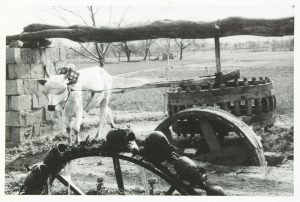
At the Ravi River at Lahore, we passed through Shahdara, where the minarets of Jahangir’s tomb rose above the trees. Of all that remains in this important Mughal city, the saddest sight was the tomb of the empress Nur Jahan. During his last years, when his health was failing, Jahangir essentially allowed this clever and intelligent woman to run his empire. When Jahangir died, Nur Jahan lost all her power. She outlived him by eighteen years in Lahore, virtually banished from court. She oversaw the completion of Jahangir’s tomb and garden and built her own nearby. The tiles decorating her tomb were stripped by the Sikhs and recycled into the monuments they built after their takeover of the Punjab in the eighteenth century. Today, urban growth has taken over most of the surrounding garden: it is cut off by a rail line and seems stranded amid the traffic.
The Elixir of Life
In Lahore, Dr. Saifur Rahman Dar, who shared our interest in Mughal gardens, met us at the city museum and gave me a copy of his book Some Ancient Gardens of Lahore (1977), hot off the press. The Lahore Museum—built in 1894 by the British, who installed John Lockwood Kipling (father of Rudyard) as curator—has a remarkable Gandharan collection. We wished we had more time there, but Dr. Dar was taking us to Shalimar, which Maura had never seen. On the street opposite the museum, as if on guard, is Zamzama (fig. 2), the great gun made famous by Rudyard Kipling in Kim.
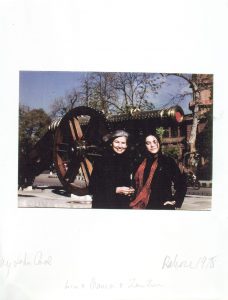
It was late afternoon when we reached Shalimar, and in the light of the setting sun, the teardrops from the fountains looked like pearls as they fell into the water in the channels. It was the perfect way to see this grand, old water garden. With its vast spaces shaded by mature trees, divided and re-divided by silvery watercourses, Shalimar is the loveliest of the old Mughal gardens because its fountains have been restored.
Water, the elixir of life, dominated the design of Mughal gardens. Without water, they are elegant empty shells. Babur is not known to have created a garden without water; he often found a spring and enclosed it. Ten by ten was his favored measurement, and he designed each garden with water as its heart. He usually referred to gardens as charbaghs, the classic quartered garden with a crossed watercourse and a pool at its center, and incorporated the charbagh in some of his own. But over time charbaghcame to mean simply a well-designed garden, and this usage has been somewhat corrupted in translation.
At the beginning of the twentieth century Constance Villiers Stuart found the Shalimar gardens “melancholy and ghost-haunted,” and she poignantly described their fate: “These large enclosures have been so often the camping ground of marauding armies while subsequent neglect and change of taste have frequently swept away the few remaining characteristics within their walls.”
She admired Lord Curzon, the creator of the Archaeological Survey of India, as “one man [who] has inspired and accomplished so much good work in so short a time.” But Mrs. Stuart’s approval was not easily won; she regretted that, “though the Mughal gardens were cleared of much accumulated overgrowth and rubbish, there has been so far no serious attempt to revive the old garden craft in its artistic and symbolic aspects.” She persistently used her influence and her book to revive an interest in that garden craft in all its aspects. This work has been carried on by Pakistanis and scholars like Dr. Dar, who are dedicated to preserving the gardens.
It was eighteen miles and a world away from Shalimar to Wagah, a village near the border crossing from Pakistan to India. After the authorities made a careful, thorough examination of all our papers, we walked across no man’s land for another careful, thorough examination of those papers. The crossing was crowded with trucks. All were unloaded; then the contents were hauled across no man’s land and reloaded onto Indian trucks. That was the routine forty years ago—slow, but months faster than the caravans of Babur’s day, when the long journey from Kabul to Agra took five or six months.
Panipat
Babur’s description of his battle at Panipat in April 1526 is one of the best-known sections of the Baburnama; it is evidently the only detailed, contemporary account of a medieval Asian military engagement, a rare and reliable source for historians. At the time it took place, Afghans had been migrating from the scenic but unproductive mountain landscape to the fertile Gangetic plain for more than a century. North India had become a patchwork of small Afghan fiefdoms, while Hindustan south of Delhi and the Aravali Hills remained a Rajput stronghold.
At Panipat, Babur defeated the combined forces of the Afghan mini states under Ibraham Lodi, the unpopular sultan of Delhi. Outnumbered roughly ten to one, Babur won victory with his swirling Mongol cavalry, archers, and careful preparation. Ibrahim Lodi had many war elephants, and Babur had some artillery, but neither proved to be critical in the engagement. Babur’s victory was a crucial step in his effort to establish rule in North India, but his battle with Rana Sanga and the Rajputs the following year was actually more difficult and decisive.
Eighty years later, in 1606, Babur’s descendant, the emperor Jahangir, visited Panipat on his first tour following his accession. He observed:
This place was always lucky for my noble fathers and respected ancestors for two great victories took place here. One was the defeat of Ibrahim Lodi by the mighty forces of His Majesty Firdaws-Makani [Babur’s posthumous name]. It is recorded in the histories of the age. The second was the victory given by fortune over the miscreant Hemu at the beginning of my exalted father’s reign. (Jahangirnama, f. 22a)
It is not surprising that Jahangir chose to visit Panipat so early in his reign. The 1526 battle is mentioned in all the imperial Mughal histories with reverence for Babur. His victory inspired his descendants—as demonstrated by the coronation of thirteen-year-old Akbar near Panipat on February 14, 1556, his grandfather Babur’s birthday. Akbar’s father, Humayun, Babur’s heir, was an ineffective ruler who had lost the throne in 1540 and spent the subsequent years in exile and battle. He finally regained control, struggled to hold Kabul, and then died in a fall six months after returning to Delhi in l555.
Akbar’s coronation on Babur’s birthday dramatized the dynastic connection and significantly strengthened his claim to rule. Akbar’s grandson, the emperor Shah Jahan, was also crowned on Babur’s birthday, February 14, 1628. The early Mughals consistently highlighted their dynastic history by linking events to dates and customs associated with Babur.
The Kabuli Bagh Mosque
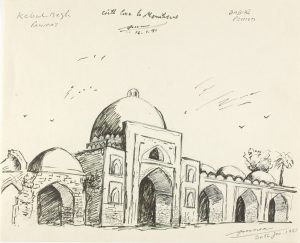
Although it is not mentioned in the Baburnama, scholars generally believe that Babur personally commissioned only one mosque, now known as the Kabuli Bagh Mosque, to commemorate his victory at Panipat (fig. 3). An inscription incised in white marble on black stone above the mihrab states, “The foundation of the mosque of His Majesty, Zahir’ud-Din Muhammad Babur Padshah Ghazi”and a quote from the Throne Verse in the Qur’an.
Based on the record, this is the first time that Babur ever built a mosque. He was more focused on succeeding in the highly competitive Timurid-Mongol dynastic struggle than on identifying with Islam. Sectarian rivalries do not appear to have held deep religious meaning or particular interest for him. He had been raised a Sunni, converted to Shi’i to gain military support from the Persian shah, and later reverted to Sunni. He renounced wine and then admitted that abstinence was a burden he regretted.
In her excellent Architecture of Mughal India, in the New Cambridge History of India series, Catherine Asher provides a plan and description of the Panipat mosque. As she notes, the plan of mosque at Panipat recalls imperial Timurid mosques in Ma waraʾ al-nahr (Transoxiana). As the only ranking Timurid ruler, Babur must have believed it was important to preserve Timurid architectural forms in the mosque he built.Babur frequently expressed regret at the Timurid defeats north of the Oxus, so it was characteristic of him to commemorate his victory in this way. Asher describes the surviving north gate, repaired and altered, as bearing a lengthy inscription that proclaims: “at the order of gold-bestowing lord of bounty, Shah Babur, was completed the mosque and the well and the Char-Bagh.” The mosque was described as near completion in 1527, and the well and garden were completed in 1528.
While the garden setting for Babur’s mosque was under construction, the area became known as the Kabuli Bagh. Today, more than four hundred years later, that is how it is still known, although it is now a populated urban neighborhood. With a family friend, I walked the area, climbing over the grass-covered remains of the brick wall that had enclosed the garden next to the mosque’s courtyard. At some distance beyond the ruined wall in the fields we spotted a few broken remains of a stone foundation. However, though there were indications that the Kabuli Bagh was originally very extensive, we could never establish its size or plan, because the area is farmed commercially. We could see that the original garden beds in the fields surrounding the mosque were now completely flat—no change in level, no paths or paving; just a well-tended, well-used truck farm. The thick vegetation, a deep emerald green, glistened in the afternoon sun as we made our way back to the mosque.

Eureka Moments
In the late 1980s, I returned to Babur’s mosque to photograph the garden area again (fig. 5). The Timurid domes and roof on the south side had collapsed long before, but on the north side it was still possible to climb to the roof near the central dome. At that height, looking down on the court, the outline of a large octagonal pool centered in front of the central bay could be seen clearly (fig. 5), although it was not visible at ground level. For me, that was one of those “eureka” moments.
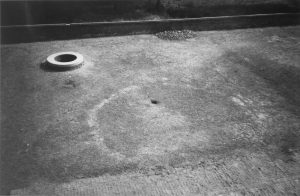
Beyond the modern wall, which foreshortened the east side of the court, sections of the original wall included remains of stone foundations of two structures—one centered on the mosque and one at the southeast corner. The central construction could have been the entrance to the enclosed garden. The extension of the court, east of the original wall, and the placement of the octagonal pool indicate that the 1527 plan was well proportioned compared to the building (unlike the modern, smaller court). The entrance court for a Friday mosque is sacred space and an important part of the entire design; the modern foreshortening at Panipat distorts the original plan. However, this is no longer a living mosque.
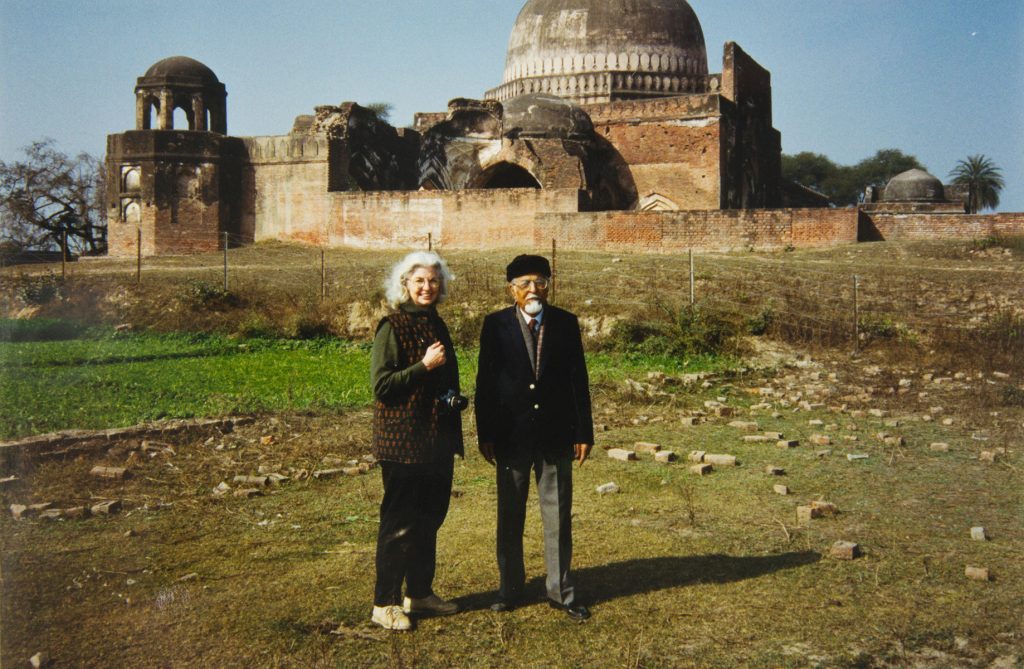
I provided photographs identifying the octagonal pool to the Archaeological Survey of India (ASI), and on my next visit to the Kabuli Bagh, I was accompanied by ASI staff members, who surveyed the garden area and the boundary of the courtyard (figs. 6, 7). Recently, Khera visited the mosque and found that the excavation of the pool had been completed. I was thrilled but not surprised to see that its dimensions were Babur’s favorite size: ten by ten!

Today, the battlefield outside Panipat is a bleak and dusty plain; locals believe it is haunted and that battle sounds can be heard at dawn. At midday when the ground shimmers under the hot sun, it is easy to imagine the Mongol horsemen, their flanking tactics confusing the Indian elephants, and the chaos, noise, and smoke caused by Babur’s men, shielded by carts, firing their matchlock rifles.

